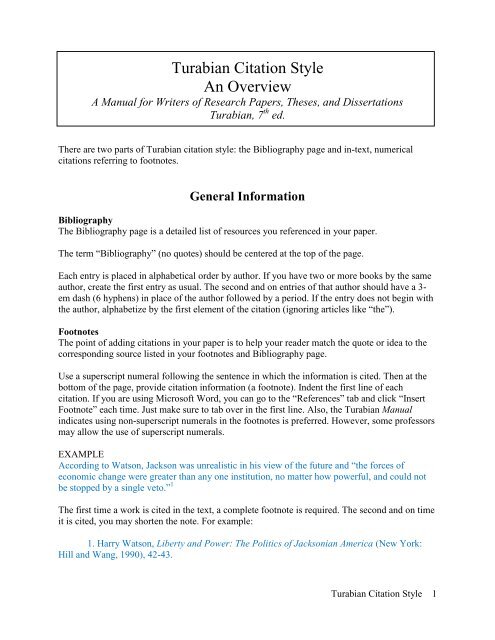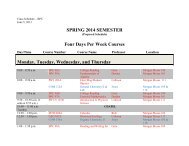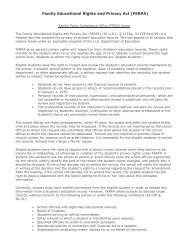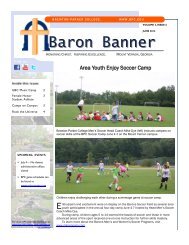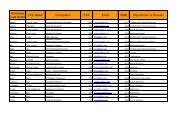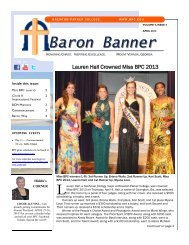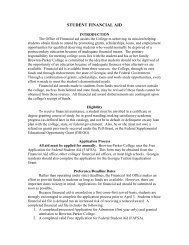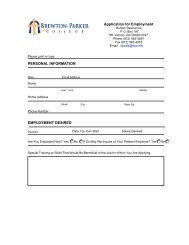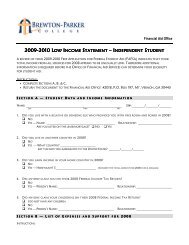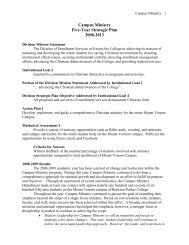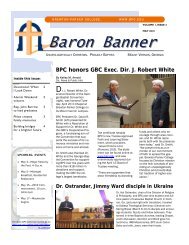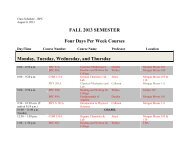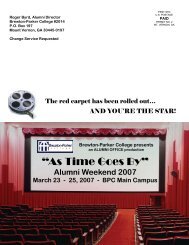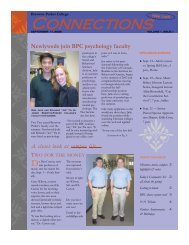Turabian Citation Style An Overview
Turabian Citation Style An Overview
Turabian Citation Style An Overview
You also want an ePaper? Increase the reach of your titles
YUMPU automatically turns print PDFs into web optimized ePapers that Google loves.
<strong>Turabian</strong> <strong>Citation</strong> <strong>Style</strong><br />
<strong>An</strong> <strong>Overview</strong><br />
A Manual for Writers of Research Papers, Theses, and Dissertations<br />
<strong>Turabian</strong>, 7 th ed.<br />
There are two parts of <strong>Turabian</strong> citation style: the Bibliography page and in-text, numerical<br />
citations referring to footnotes.<br />
General Information<br />
Bibliography<br />
The Bibliography page is a detailed list of resources you referenced in your paper.<br />
The term “Bibliography” (no quotes) should be centered at the top of the page.<br />
Each entry is placed in alphabetical order by author. If you have two or more books by the same<br />
author, create the first entry as usual. The second and on entries of that author should have a 3-<br />
em dash (6 hyphens) in place of the author followed by a period. If the entry does not begin with<br />
the author, alphabetize by the first element of the citation (ignoring articles like “the”).<br />
Footnotes<br />
The point of adding citations in your paper is to help your reader match the quote or idea to the<br />
corresponding source listed in your footnotes and Bibliography page.<br />
Use a superscript numeral following the sentence in which the information is cited. Then at the<br />
bottom of the page, provide citation information (a footnote). Indent the first line of each<br />
citation. If you are using Microsoft Word, you can go to the “References” tab and click “Insert<br />
Footnote” each time. Just make sure to tab over in the first line. Also, the <strong>Turabian</strong> Manual<br />
indicates using non-superscript numerals in the footnotes is preferred. However, some professors<br />
may allow the use of superscript numerals.<br />
EXAMPLE<br />
According to Watson, Jackson was unrealistic in his view of the future and “the forces of<br />
economic change were greater than any one institution, no matter how powerful, and could not<br />
be stopped by a single veto.” 1<br />
The first time a work is cited in the text, a complete footnote is required. The second and on time<br />
it is cited, you may shorten the note. For example:<br />
1. Harry Watson, Liberty and Power: The Politics of Jacksonian America (New York:<br />
Hill and Wang, 1990), 42-43.<br />
<strong>Turabian</strong> <strong>Citation</strong> <strong>Style</strong> 1
Thereafter, the citation would be:<br />
4. Watson, 82. (Author, Page)<br />
OR<br />
4. Watson, Liberty and Power, 82 (Author, Shortened Title, Page)<br />
Some professors may want simply the author and page number (provided two works from the<br />
same author are not cited in the paper). Others may ask for a shortened (4 words or less) form of<br />
the title included as well.<br />
If you are citing the same work immediately after its previous citation, you may use Ibid. Use a<br />
comma and page number if the page is different (as in number 5 from the example below). Once<br />
you are on a new page, you should provide the shortened footnote, not Ibid. again. (You can‟t<br />
carry Ibid. over from a previous page).<br />
EXAMPLE<br />
4. Watson, 82<br />
5. Ibid., 96<br />
6. Ibid.<br />
Examples of Specific Types of Entries<br />
“N” indicates the footnote; “B” indicates the corresponding bibliography entry.<br />
Books<br />
Basic format<br />
N: 1. Author First Name Last Name, Book Title (Place of Publication: Publisher, Date), Page<br />
Number(s).<br />
B: Author Last Name, First Name. Book Title. Place of Publication: Publisher, Year.<br />
Edition number is placed after book title and the comma following as a number followed by ed.<br />
(e.g. 2nd ed.)<br />
EXAMPLE:<br />
N: 2. Joseph S. Nye Jr, The Paradox of American Power: Why the World’s Only Superpower<br />
Can’t Go It Alone (New York: Oxford University Press, 2002), 156-157.<br />
B: Nye Jr., Joseph S. The Paradox of American Power: Why the World’s Only Superpower Can’t<br />
Go It Alone. New York: Oxford University Press, 2002.<br />
<strong>Turabian</strong> <strong>Citation</strong> <strong>Style</strong> 2
Chapter in book<br />
N: 3. Author First Name Last Name, “Chapter Title,” in Book Title, ed. Editor First Name<br />
Last Name (Place of Publication: Publisher, Year), Page number(s).<br />
B: Author Last Name, First Name. “Chapter Title.” In Book Title, edited by Editor First Name<br />
Last Name, Page range. Place of Publication: Publisher, Year.<br />
EXAMPLE:<br />
N: 4. Joan L. Coffey, “The First Indochina War: Perceptions and Realities of French and<br />
American Policy,” in The Vietnam War: Handbook of the Literature of Research, ed. James S.<br />
Olson (Westport, CT: Greenwood Press, 1993), 76.<br />
B: Coffey, Joan L. “The First Indochina War: Perceptions and Realities of French and American<br />
Policy.” In The Vietnam War: Handbook of the Literature of Research, edited by James<br />
S. Olson, 71-90. Westport, CT: Greenwood Press, 2006.<br />
Periodicals<br />
Scholarly Journal Article<br />
N: 5. Author First Name Last Name, “Article Title,” Journal Title Volume, no. __<br />
(Publication date): Page number(s).<br />
B: Author Last Name, First Name. “Article Title.” Journal Title Volume, no. __ (Publication<br />
date): Page range.<br />
EXAMPLE:<br />
N: 6. Judith Keene, “Lost to Public Commemoration: American Veterans of the „Forgotten‟<br />
Korean War,” Journal of Social History 44, no. 4 (Summer 2011): 1096.<br />
B: Keene, Judith. “Lost to Public Commemoration: American Veterans of the „Forgotten‟<br />
Korean War.” Journal of Social History 44, no. 4 (Summer 2011): 1095-1113.<br />
For 2 or 3 authors:<br />
In the footnote, add author names in same format as the first author name with a comma<br />
in between the 1 st and 2 nd name (if 3 authors) and a “,and” before the last name.<br />
In the bibliography, the 2 nd and 3 rd authors are added in the same format as the footnote—<br />
author first name before last name.<br />
This format is the same for book entries.<br />
For 4 or more authors:<br />
N: 7. Author 1 First Name Last Name et al., “Article Title,” Journal Title Volume, no. __<br />
(Publication Date): Page Numbers.<br />
<strong>Turabian</strong> <strong>Citation</strong> <strong>Style</strong> 3
B: Author 1 Last Name, First Name, Author 2 First Name Last Name, Author 3 First Name Last<br />
Name, Author 4 First Name Last Name, and [so on]. “Article Title.” Journal Title<br />
Volume, no. __ (Date of Publication): Page range.<br />
EXAMPLE:<br />
N: 8. Jillian F. Ikin et al., “Comorbidity of PTSD and Depression in Korean War Veterans:<br />
Prevalence, Predictors, and Impairment,” Journal of Affective Disorders 125, no. 1 (September<br />
2010): 280.<br />
B: Ikin, Jillian F., Mark C. Creamer, Malcom R. Sim, and Dean P. McKenzie. “Comorbidity of<br />
PTSD and Depression in Korean War Veterans: Prevalence, Predictors, and Impairment.”<br />
Journal of Affective Disorders 125, no. 1 (September 2010): 279-286.<br />
Newspaper Article<br />
Newspaper articles are usually only cited in the footnotes and not included as part of the<br />
bibliography.<br />
N: 9. Author First Name Last Name, “Article Title,” Newspaper Title, Publication Date.<br />
EXAMPLE:<br />
N: 10. Tom A. Peter, “Karzai Blasts US, NATO for 'Using' Afghanistan, <strong>An</strong>nounces Taliban<br />
Talks,” Christian Science Monitor, June 19, 2011.<br />
Websites<br />
N: 11. Author, “Title of the Page,” Title or owner of the site, http:// ________ (accessed<br />
Month Day, Year).<br />
B: Author. “Title of the Page.” Title or owner of the site. http:// ____________(accessed Month<br />
Day, Year.<br />
If no author given, provide name of owner of the site in its place.<br />
EXAMPLE:<br />
N: 12. National Memorial Project Foundation, “History of the Memorial,”<br />
http://www.mlkmemorial.org/site/c.hkIUL9MVJxE/b.1190613/k.5EE9/History_of_the_Memoria<br />
l.htm (accessed September 1, 2011).<br />
B: National Memorial Project Foundation. “History of the Memorial.”<br />
http://www.mlkmemorial.org/site/c.hkIUL9MVJxE/b.1190613/k.5EE9/History_of_the_<br />
Memorial.htm (accessed September 1, 2011).<br />
Updated: September 2, 2011<br />
<strong>Turabian</strong> <strong>Citation</strong> <strong>Style</strong> 4


